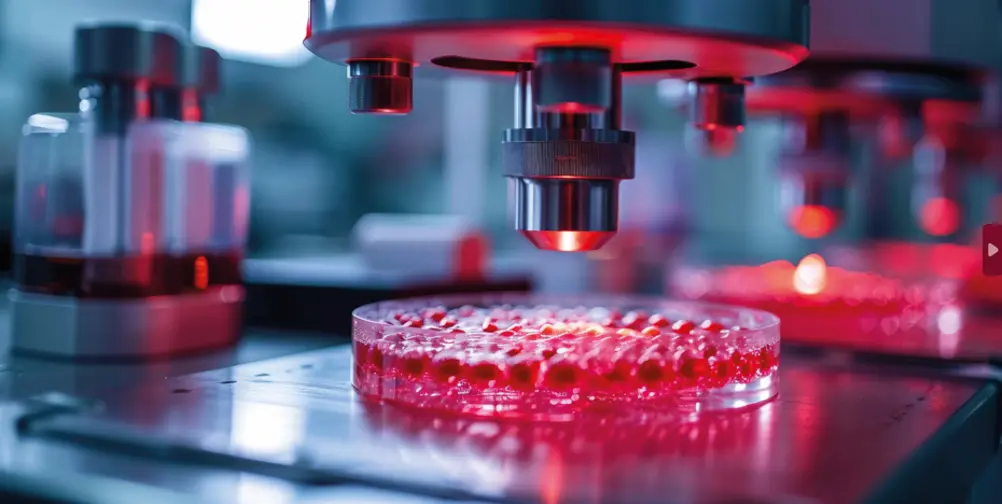Introduction to Bioprinting: A Leap Forward in Medical Science
In recent years, lab-grown tissues have played a vital role in pharmaceutical testing, providing safe alternatives to animal testing and reducing the dependency on costly human trials. However, traditional 3D bioprinting has presented its own set of challenges, such as prolonged development times and limitations in tissue complexity. Researchers from the University of Melbourne‘s Collins BioMicrosystems Laboratory have now introduced a transformative bioprinting approach, using acoustic waves to swiftly and effectively form complex human tissue structures, including brain matter, cartilage, and bone cultures.
This breakthrough promises to redefine the way scientists create human tissue for research, potentially leading to faster drug testing, personalized treatment options, and further advancements in regenerative medicine.
What is 3D Bioprinting and Why is it Essential?
Traditional 3D bioprinting methods have been an invaluable tool for researchers, allowing the construction of living tissues layer-by-layer. However, these methods are typically slow, complex, and can damage the delicate cells due to prolonged exposure. The layering technique often requires hours to assemble a single tissue sample, which impacts the viability of cells and limits the precision of the structure.
Conventional bioprinting methods are typically a two-step process:
- Layering Cells: Cells are positioned layer-by-layer to form tissue over several hours.
- Transferring for Analysis: The fragile tissue is then moved to lab plates for further study, risking damage in the process.
Acoustic Wave Technology: A Game-Changer in Bioprinting
The University of Melbourne’s acoustic wave bioprinting method is revolutionary because it eliminates many of the limitations faced by conventional 3D bioprinting. Rather than depending on intricate layer-by-layer printing, this new system uses soundwaves to precisely position and assemble cells in a fraction of the time. According to David Collins, head of the Collins BioMicrosystems Laboratory, precise cellular arrangement is essential for accurate tissue function, much like the precise assembly of a car’s parts.
How Acoustic Waves Work in Bioprinting
This new method involves using soundwaves to create vibrations in microscopic bubbles, guiding cells into specific formations. Once the base structure is in place, researchers can guide tissue development and maturation without the prolonged exposure that can harm cell integrity. The technique is reportedly up to 350 times faster than traditional bioprinting processes, allowing scientists to generate tissue samples in just minutes, compared to hours.
This advancement enables direct printing onto lab plates, which maintains the tissue’s sterility, reduces cell damage, and minimizes contamination. With such efficiencies, this approach could make lab-grown tissue samples far more accessible for drug testing, accelerating research and reducing costs across medical fields.
Why Accurate Cell Positioning Matters in Bioprinting
One of the critical aspects of successful tissue creation lies in the accurate positioning of cells. Traditional bioprinters rely on cells aligning naturally, which often results in inconsistencies and cellular damage. This can compromise the tissue’s structural integrity, rendering it less effective for research purposes. With acoustic wave bioprinting, cells are meticulously guided into place, creating a more accurate representation of actual human tissue structures.
David Collins highlighted how misalignment issues contribute to the failure of many bioprinters to replicate authentic tissue structures. Acoustic wave bioprinting addresses this limitation by providing researchers with the precision needed to construct tissue that better resembles human organs and functions.
Potential Applications of Acoustic Wave Bioprinting in Medicine
The implications of this breakthrough are profound. By enabling the creation of complex tissues at unprecedented speeds, this bioprinting technology could significantly impact various areas of healthcare:
- Accelerated Drug Testing: Researchers could quickly generate human tissue samples to test pharmaceuticals, helping to streamline drug development and improve safety.
- Personalized Medicine: In the future, medical facilities could use a patient’s own cells to create miniature disease models, offering insights into how individual patients might respond to specific treatments.
- Regenerative Medicine: Acoustic bioprinting could assist in producing replacement tissues and organs, supporting regenerative medicine applications such as wound healing and tissue repair.
Future Prospects and Challenges
As with any cutting-edge technology, further research and refinement are necessary. Although promising, acoustic wave bioprinting requires additional testing to fully realize its potential for clinical and commercial applications. The University of Melbourne’s team envisions a future where hospitals and research facilities routinely use acoustic bioprinters for both research and patient care, unlocking new possibilities in personalized healthcare.
To explore more about the Collins BioMicrosystems Laboratory’s work, visit their [official website](https://www.unimelb.edu.au/). Additionally, for those interested in learning about the latest advancements in bioprinting, [Nature Journal](https://www.nature.com/) frequently publishes studies on innovative biomedical engineering research.
Revolutionizing Bioprinting with Acoustic Waves
The development of acoustic wave bioprinting by the University of Melbourne represents a major milestone in medical research. By significantly reducing the time and improving the precision needed to create lab-grade tissues, this technology has the potential to transform bioprinting from a slow and intricate process into a rapid, highly efficient tool for researchers and clinicians alike. This breakthrough paves the way for advancements in drug testing, personalized medicine, and regenerative treatments, offering a glimpse into a future where lab-grown human tissues are readily available for a variety of medical applications.
For More Updates: Emerging Technologies


